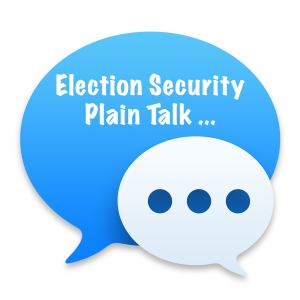Plain Talk Series on Election Security #3: The One and Only Reason to End Paperless Voting
John Sebes

This is the 3rd of a 7-part series of election security vignettes intentionally kept as brief as possible to stick to the main point of the title above. Its intended to acquaint relatively new-comers to election integrity and security, and that includes anyone and everyone from concerned citizens, to journalists, to policy makers.
Continuing the focus on election security in the news, litigation, political debate … this time about completely unnecessary confusion over why we need to stamp out paperless voting – more specifically: replace the old DRE machines, and move to modern ballot marking devices that collect voter choices and produce a paper record to be optically scanned along with hand-marked ballots.
Unfortunately, there seem to be a number of competing reasons to do so, with arguments over pro and con of each. But reality, there is only one reason to stop using paperless voting machines:
- Voting machines are computers.
- We can’t trust computers to work 100% correctly 100% of the time.
- For important tasks, people need to be able to cross-check the computers’ results, with a durable paper record that the voter had the opportunity to verify.
That’s just basic common sense about computing. Applied to voting, what it means is this basic disparity: for voters who vote on paper counted by computers, election officials can spot check by picking a statistically sound sample of ballots, and for each one, comparing the human-readable record with the recorded machine interpretation, and recording the variances.
But for voters who use paperless voting machines, there is nothing that election officials have to compare with the machine-generated vote tallies. We have to accept the computers’ numbers on faith.
It’s just not acceptable that some voters are protected from machine malfunction, and others are not.
But it’s worse than that: all voters suffer. In this ballot audit process, the goal is to total up the variances, and ensure that all the variances are small enough to not change any election result. But this goal can’t be met when some voters were prevented from producing any paper ballot at all! For those voters, there is no way to find a variance between what the voter meant, and what the machine recorded. Even if an audit finds no significant variance in the machine count of paper ballots, there could still be very significant variance in the paperless voting, and we’d never know.
As a result, if even a small fraction of voters are prevented from submitted a paper ballot, the results of the whole election are based on faith in technology, not evidence from election officials.
Yet in our current litigation, debate, and legislation, the discussion of election technology wanders across a varying landscape of issues that are completely secondary. For example:
- Do voting machines really preserve ballot anonymity?
- How “hackable” is this kind of voting machine compared to another? Says who?
- If it’s not connected to the Internet, it’s “secure,” right?
- Paper ballots enable voter fraud, that’s more important, right?
And on and on. Here is my least favorite one:
There is no evidence that Russians hacked voting machines, and that’s nearly as good as evidence that they did not, and hence probably nobody can, so let’s not worry about voting machine hacking.
Tempted as I am to argue the faulty logic, that would be making the same mistake as so many people in the current discussion: getting sucked into a side issue when the main issue is simple.
The bad news for a lot of critical computing is that we can’t trust the computers 100%. The good news for computers in voting is that there is a simple expedient way to detect and correct when computers have made a mistake – let people spot check the paper ballots.
For that good news to be a nationwide reality, we need to move ahead on two related fronts:
- Get to nationwide “one voter, one paper ballot.”
- Get to nationwide use of those spot checking methods.
If we can stick to just the one reason to make those moves, maybe it will happen more quickly.
Next: Why Not to Trust a Computer With Your Vote
To read more, here are all of the articles in this Election Security Plain Talk Series.



